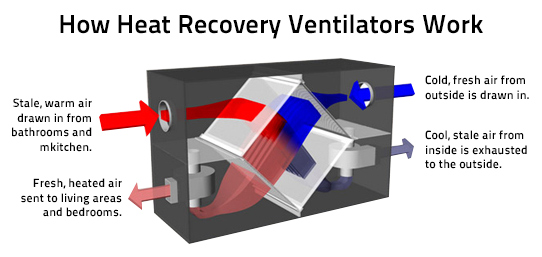The All-Inclusive Overview to the Uses of Heat Recovery Ventilation in Modern Buildings
Heat Recovery Ventilation (HRV) systems stand for a considerable improvement in developing innovation (HRV Heat Recovery Ventilation). They offer an approach for exchanging stagnant indoor air with fresh outside air while reducing power loss. This strategy not only enhances interior air quality yet additionally adds to energy performance in both domestic and commercial structures. Recognizing the various applications and benefits of HRV can disclose its critical function in modern-day style and sustainability initiatives. The implications of this innovation deserve discovering further
Understanding Heat Recovery Ventilation Systems

Several contemporary buildings prioritize power effectiveness, comprehending warm recovery ventilation (HRV) systems is essential for enhancing interior air high quality and lowering power consumption. HRV systems work by moving heat from stagnant interior air to inbound fresh air, effectively preserving comfortable indoor temperature levels while lessening energy loss. These systems contain a heat exchanger, followers, and ductwork that assist in the blood circulation of air. During wintertime, HRV devices record and reuse heat from the outward bound air, while in summer, they can assist cool incoming air. By constantly trading air, HRV systems additionally reduce humidity and the concentration of indoor contaminants. Proper installment and upkeep of HRV systems are crucial for their efficiency and performance in improving general building performance and comfort.
Advantages of Heat Recovery Ventilation
Heat recovery ventilation systems supply various benefits that enhance both power efficiency and indoor air top quality in modern-day structures. By recording and recycling power from exhaust air, these systems substantially minimize heating & cooling prices, bring about lower energy intake. Moreover, they keep a constant flow of fresh outside air, decreasing the danger of indoor air toxins and irritants. This continual exchange assists control humidity degrees, stopping mold growth and ensuring a much healthier living atmosphere. Furthermore, HRV systems add to sustainability objectives by decreasing general carbon impacts. Their capacity to enhance ventilation without giving up thermal convenience makes them a useful addition to contemporary building design, promoting both financial and environmental benefits.
Applications of HRV in Residential Structures
As house owners significantly prioritize power efficiency and indoor air quality, the applications of heat recuperation ventilation (HRV) systems in residential buildings have actually become more widespread. HRV systems are especially beneficial in securely secured homes, where maintaining fresh air blood circulation is vital for stopping moisture buildup and indoor toxins. They effectively move warm from outbound stale air to incoming fresh air, decreasing energy prices related to cooling and heating. Furthermore, HRVs can boost comfort levels by regulating moisture and temperature. They are likewise versatile for different domestic designs, including single-family homes and multi-unit structures. Generally, integrating HRV systems sustains sustainable living methods while making sure a much healthier interior environment for owners.
HRV in Commercial and Industrial Setups
In business and commercial settings, the execution of heat recuperation air flow (HRV) systems has ended up being significantly important for enhancing power performance and preserving air high quality. These systems successfully move heat from exhaust air to incoming fresh air, minimizing the requirement for added home heating or air conditioning. This not only lowers energy costs but likewise contributes to sustainability efforts. Industries such as manufacturing, warehousing, and office complex benefit considerably from HRV systems, as they assist manage temperature and moisture degrees, guaranteeing a comfy and effective environment. HRV systems help in eliminating contaminants and excess wetness, enhancing indoor air top quality. As regulations around air quality end up being more stringent, the adoption of HRV technology is likely to expand, making it a crucial element of modern-day industrial and commercial infrastructure.
Future Patterns in Heat Recovery Ventilation Technology

Often Asked Questions
Just How Does Heat Recovery Ventilation Influence Indoor Air Top Quality?
Heat recovery ventilation significantly boosts interior air top quality by continuously exchanging stale interior air with fresh exterior air while recovering power. This process decreases toxins, maintains ideal humidity degrees, and ensures a much healthier setting for passengers.
Can HRV Equipments Be Mounted in Existing Buildings?
HRV systems can certainly be installed in existing structures. Retrofitting might need modifications to ductwork and air flow layouts, however it considerably boosts energy performance and indoor air high quality, making it a feasible choice for older frameworks.
What Upkeep Is Required for HRV Solutions?

Exist Particular Climates Where HRV Is A Lot More Effective?
Heat recovery ventilation systems are specifically efficient in environments look at more info with significant temperature distinctions visit this site right here between seasons. These systems enhance power effectiveness by recouping warm from exhaust air, making them ideal for both chilly and moderately warm environments.
Exactly How Do HRV Equipments Affect Energy Costs?
